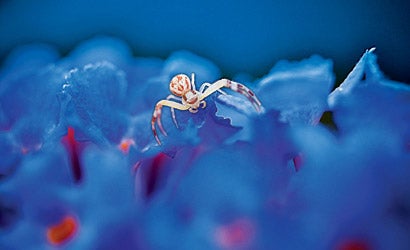The $75 Close-Up Kit
Go macro without the weight or cost of a macro lens.

We may earn revenue from the products available on this page and participate in affiliate programs. Learn more ›
A spider’s four eyes, the pattern on a snake’s back, the razor edge of an owl’s beak. To capture the tiniest details, you have to get close — sometimes even closer than your lens allows. That’s when it’s time for extension tubes.
Sure, you can use dedicated macro lenses, but they can be expensive and heavy, especially on a long backpacking trip. And for each focal length, you need a different lens.
Tubes overcome these drawbacks and give you other benefits such as reducing the minimum focusing distance when you’re shooting with a long telephoto lens. (That’s how I got the shot of the snowy owl at left.) Plus, you can use them with a macro lens to boost magnification even further.
Extension tubes are light, rugged, affordable (about $75 for a short, full-function model), and can be used with almost any lens in your arsenal. They provide macro focusing with little or no reduction in sharpness. While they reduce the brightness of your lens, they work with your camera’s TTL metering, so your exposures will most likely be on the mark without any extra calculations or trial-and-error in the field.
Don’t mistake an extension tube for a teleconverter. A tube is essentially a hollowed-out, lightproof connector that adds distance between the back of your lens and the image sensor, allowing you to take photos at closer distances to the subject. While a teleconverter looks very similar, it contains lens elements and increases the focal length of the lens (i.e., a 200mm with a 2X converter effectively becomes 400mm). The teleconverter is specialized for long-range shots (think wolves in Yellowstone), while tubes magnify the image by allowing you to get closer (think hummingbirds in a feeder a few feet away). Another major difference is that you can focus to infinity with a teleconverter, but an extension tube has a limited focusing zone.
An advantage of tubes is that they can be stacked for greater effect. For instance, you can put two 25mm tubes together, or add a 25mm to a 50mm tube. This greatly increases your magnifying power.
Try not to overdo it, though. If the image is still out of focus when the subject is almost touching your lens, the front element is actually blocking you from the proper focus zone. Reduce the number of tubes, or use a lens that has a longer focal length. The longer your lens, the less close-up magnification you’ll get from an extension tube.
I’ve narrowed down my extension tube setups to three that cover almost every situation I encounter as a nature photographer: a 50mm macro lens with a 25mm tube (for most close-ups), a 70-200mm zoom with a 25mm tube (for closer tele focusing with larger subjects), and the 50mm macro combined with stacked 12mm and 25mm tubes (for extreme close-ups).